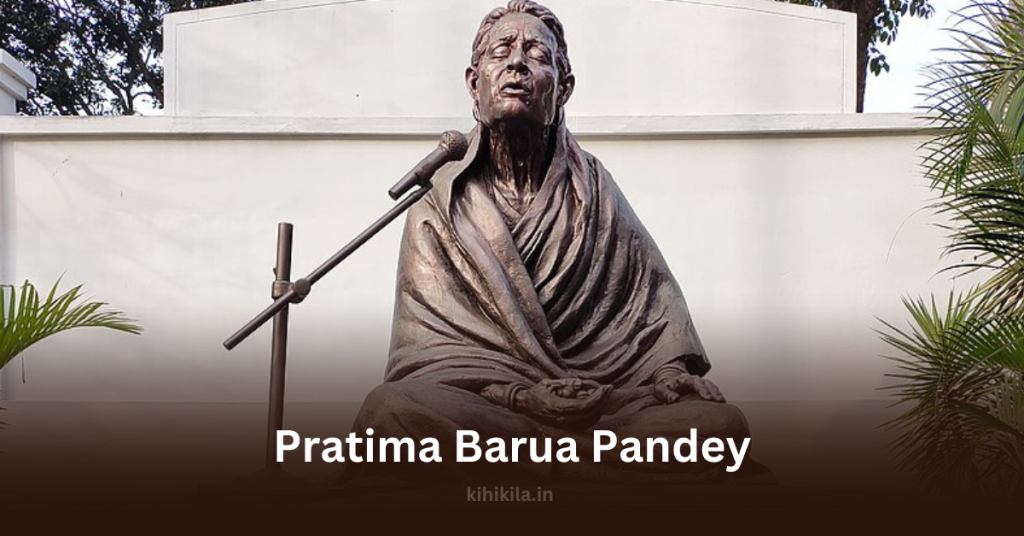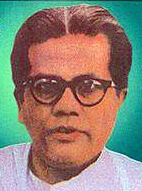Pratima Barua Pandey was one of Assam’s most cherished folk artists, remembered for her significant contributions to preserving and popularizing the traditional Goalpariya lokageet (folk songs of the Goalpara region). Born into the royal family of Gauripur in Dhubri district, she carved a niche for herself in Assamese cultural history with her soulful music and passion for folk traditions.
This article sheds light on her inspiring journey, her contributions to Assamese culture, and the lasting legacy she left behind.
Early Life and Royal Upbringing
Pratima Barua Pandey was born on October 3, 1935, in Kolkata. Her early years were spent moving between Kolkata and Gauripur, balancing the bustling city life with the calm surroundings of her family estate by the riverside “Gadadhar” in Gauripur. She completed her initial education at Gokhale Memorial School in Kolkata before moving to Assam to study at Girls’ High School in Gauripur.
Although she learned Rabindrasangeet during her school days, she never received formal training in music. Her primary inspiration came from her father, Prakitesh Chandra Barua (Lalji), who recognized her talent and encouraged her passion for music.
Reviving Goalpariya Folk Songs
Pratima Barua Pandey’s most notable achievement was the revival of Goalpariya lokageet, which was on the verge of fading from public memory. These folk songs, primarily sung by the Rajbanshi community of western Assam, Bengal, Bihar, and neighboring regions, were slowly being forgotten due to changing socio-political conditions.

The displacement and cultural shifts following colonial rule had pushed these traditional songs into obscurity. However, Pratima Barua’s determination and talent brought them back to life. Her heartfelt renditions, rooted in the experiences of farmers, mahouts, and ordinary people, struck a chord with listeners and gave these songs a new lease of life.
The Turning Point: Bhupen Hazarika’s Support
In 1955, Pratima Barua’s talent came to the forefront when Dr. Bhupen Hazarika, the iconic Assamese musician and filmmaker, visited Gauripur. During a social gathering (jalsa), Pratima performed Goalpariya lokageet with instruments like the dhol, dotora, junuka, and bashi.
Deeply impressed by her voice and unique style, Dr. Hazarika predicted that she would take these folk songs to great heights. His support proved pivotal, as he introduced her music to a wider audience. In 1961, he facilitated the broadcast of her songs on All India Radio, Guwahati, which marked a turning point in her career.
Overcoming Challenges
Pratima Barua Pandey’s journey was not without challenges. When her songs were first broadcast on the radio, they faced criticism from sections of Assamese society that accused them of being “non-Assamese” or “Bengali.” Despite this backlash, she persevered, and over time, her music gained widespread acceptance.
Her performances at events like the Assam Sahitya Sabha and the All Assam Students’ Union further solidified her position as a legendary folk artist. She also collaborated with the Indian People’s Theatre Association (IPTA), adding to her cultural impact.
Personal Life and Other Contributions
Pratima Barua Pandey married Gauri Shankar Pandey, a retired principal of Gauripur P. B. College. Apart from Goalpariya lokageet, she often performed Paul Robeson’s iconic song, “We Are in the Same Boat Brother,” during her stage shows.
Her contributions extended beyond music. By popularizing the songs of the Goalpara region, she also played a crucial role in preserving the language and culture of the Rajbanshi community.
Awards and Recognition
Pratima Barua Pandey’s efforts were widely acknowledged, earning her several prestigious awards:
- Padma Shri – Recognizing her contributions to Indian folk music.
- Sangeet Natak Akademi Award – Honoring her pioneering work in Assamese folk music.
In 1997, a documentary film on her life, Hastir Kanya, directed by Prabin Hazarika, won the National Award for Best Biographical Film. This documentary also gained international acclaim at the South Asia Film Festival in 1998.
A Legacy That Lives On
Pratima Barua Pandey passed away on December 27, 2002, at GNRC Hospital in Guwahati. Her death left a profound void in Assam’s cultural landscape. On the day of her cremation, thousands of people lined the roads to pay their last respects, braving rain to bid farewell to their beloved “princess.”
Her music continues to resonate with audiences, with songs like Hastir Kanya and Mur Mahut Bandhure standing as timeless classics. She is remembered not only as a singer but also as a cultural icon who bridged the gap between tradition and modernity.
Unique Insights from Our Platform
- We provide detailed and comprehensive content on cultural icons like Pratima Barua Pandey, ensuring students understand their historical and cultural significance.
- Our focus extends beyond basic information, highlighting lesser-known facts such as her early struggles and the socio-political backdrop of her work.
- By connecting her story to broader cultural and linguistic movements, we offer a deeper understanding of her impact on Assamese identity.
Pratima Barua Pandey’s life is a testament to the power of music in preserving heritage and uniting communities. Her legacy will continue to inspire generations to cherish and protect their cultural roots.
FAQ’s:
Q 1. Who was Pratima Barua Pandey?
Pratima Barua Pandey was a renowned folk singer from Assam, known for popularizing the Goalpariya lokageet, traditional folk songs from the Goalpara region.
Q 2. What are Goalpariya lokageet?
Goalpariya lokageet are traditional folk songs originating from the Goalpara region in Assam. They reflect the culture, lives, and traditions of the local communities, especially the Rajbanshis.
Q 3. What were Pratima Barua Pandey’s most famous songs?
Her most popular songs include Hastir Kanya and Mur Mahut Bandhure, which are considered classics in Assamese folk music.
Q 4. What was Pratima Barua Pandey’s role in Assamese culture?
She played a vital role in reviving Goalpariya lokageet and preserving the folk culture and language of the Rajbanshi community, which was on the verge of disappearing.
Q 5. What awards did Pratima Barua Pandey receive?
She was honored with the Padma Shri and the Sangeet Natak Akademi Award for her contributions to folk music.
Q 6. What is the significance of the documentary Hastir Kanya?
Directed by Prabin Hazarika, Hastir Kanya is a documentary about Pratima Barua Pandey’s life and work. It won the National Award for Best Biographical Film in 1997.
Q 7. Who supported Pratima Barua Pandey in her musical journey?
Dr. Bhupen Hazarika, a legendary Assamese musician, played a pivotal role in promoting her music and introducing it to a wider audience.
Q 8. How did Pratima Barua Pandey contribute to the preservation of the Rajbanshi language and culture?
By performing and popularizing Goalpariya lokageet, she brought attention to the Rajbanshi language and traditions, helping preserve their cultural identity.
Q 9. What challenges did Pratima Barua Pandey face during her career?
Her songs initially faced criticism for being labeled as “non-Assamese” or “Bengali.” However, her perseverance helped her gain widespread recognition and acceptance.
Q 10. What is Pratima Barua Pandey’s legacy?
Pratima Barua Pandey is remembered as a cultural icon who preserved Assamese folk traditions and inspired future generations to value and protect their cultural heritage.












